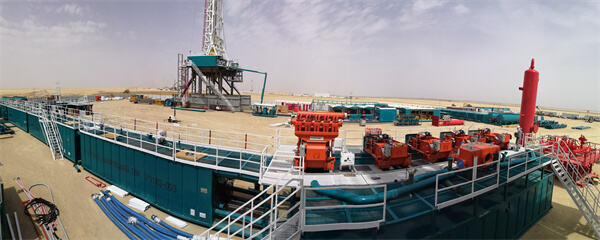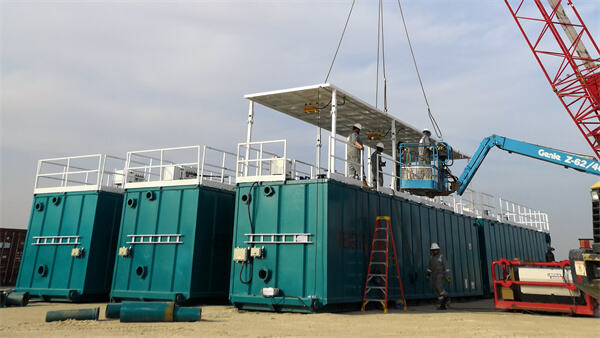Արդյունաբերական թափոնների մշակման գործողությունների առավելագործում
Ներկայումս յուղոտ տղմի կառավարումն ու մշակումը դարձել է ավելի քան երբևէ կարևոր արդյունաբերական ոլորտում: Քանի որ շրջակա միջավայրի նկատմամբ կանոնները խստանում են, իսկ կայունության պահանջները աճում, ընկերությունները ստիպված են օպտիմալացնել յուղոտ տղմի մշակման գործընթացները՝ համապատասխանելու ինչպես շահագործման արդյունավետությանը, այնպես էլ շրջակա միջավայրի համապատասխանությանը: Այս համապարփակ ուղեցույցը ներկայացնում է ամենանոր մեթոդներն ու ապացուցված ռազմավարությունները՝ մշակման արդյունավետությունը բարձրացնելու, ինչպես նաև ծախսերն ու շրջակա միջավայրի վրա ազդեցությունը նվազեցնելու համար:
Առաջադեմ մշակման տեխնոլոգիաներ և մեթոդներ
Տերմինալ Դեսորբցիայի Սիստեմներ
Ջերմային դեսորբցիան համարվում է ամենաարդյունավետ մոտեցումներից մեկը երկար Կանգնած Օդանավների Կառավարում այս տեխնոլոգիան վերահսկվող ջերմություն է օգտագործում՝ հիդրոկարբոնները պինդ նյութերից առանձնացնելու համար, որն ապահովում է մինչև 99,9% առանձնացման արագություն: Ժամանակակից ջերմային դեսորբցիայի սարքերը ներառում են ճշգրիտ ջերմաստիճանի վերահսկողություն և առաջադեմ գոլորշիների վերականգնման համակարգեր, որոնք զգալիորեն բարելավում են մշակման արդյունավետությունը՝ նվազեցնելով էներգիայի սպառումը:
Ջերմային դեզորբցման տեխնոլոգիայի վերջերս մտցված նորարարություններից են փոփոխական հաճախականության վարուղիները, ջերմության վերականգնման համակարգերը և ավտոմատացված կերակրման կառավարման մեխանիզմները: Այս բարելավումները հանգեցրել են մշակման ժամանակի կրճատմանը և արժեքավոր հիդրոկարբոնների վերականգնման բարձրացմանը, ինչը բուժման գործընթացը ավելի տնտեսապես շահավետ է դարձնում:
Ցենտրիֆուգացում և բաժանման տեխնիկա
Առաջատար ցենտրիֆուգացման համակարգերը հեղափոխություն են կատարել յուղոտ աղբի մշակման գործում՝ առաջարկելով գերազանց բաժանման հնարավորություններ: Երեք ֆազային դեկանտացող ցենտրիֆուգաները կարող են միաժամանակ բաժանել յուղը, ջուրը և պինդ մասնիկները, ինչը կտրուկ բարելավում է մշակման արդյունավետությունը: Վերջերս մշակված ցենտրիֆուգացման սարքավորումներն ունեն ավտոմատ տարբերական արագության կառավարում և բարելավված ամանի կառուցվածք, ինչը հանգեցնում է ավելի մաքուր բաժանման և էներգիայի սպառման կրճատման:
Ցենտրիֆուգացման սարքավորումների հետ իրական ժամանակում ներդրված հսկման համակարգերը թույլ են տալիս անընդհատ օպտիմալացնել բաժանման պարամետրերը՝ ապահովելով նավթի առավելագույն վերականգնումը և մշտական մշակման որակ:

Քիմիական լրացուցիչ ռազմավարություններ
Մակերևութային ակտիվ նյութերի ընտրություն և կիրառում
Մակերևութային ակտիվ նյութերի ռազմավարական կիրառումը կարևոր դեր է խաղում յուղոտ տեղամի մշակման արդյունավետության բարձրացման գործում: Ժամանակակից մակերևութային ակտիվ նյութերի բաղադրությունները հատուկ նախատեսված են բարդ էմուլսիաների քայքայման և յուղի, ջրի և պինդ մասնիկների ավելի լավ բաժանման համար: Հարմար մակերևութային ակտիվ նյութերի ընտրությունը կախված է տեղամի հատկություններից, ջերմաստիճանային պայմաններից և ցանկալի մշակման արդյունքներից:
Այժմ առաջադեմ մակերևութային ակտիվ նյութերի տեխնոլոգիաները ներառում են կենսածագում ունեցող այլընտրանքներ, որոնք ավելի լավ էկոլոգիական համատեղելիություն են ապահովում՝ պահպանելով բարձր մշակման արդյունավետությունը: Այս նորարարությունները հանգեցրել են քիմիական նյութերի սպառման կրճատմանը և մշակման արդյունքների բարելավմանը:
Քիմիական պայմանավորման օպտիմալացում
Ճիշտ քիմիական պայմանականությունը կեղտաջրերի մշակման գործընթացների հաջողության վրա զգալի ազդեցություն է թողնում: Առաջադեմ քիմիական ծրագրերը միավորում են բազմաթիվ ագենտներ, ներառյալ դեմուլսիֆիկատորներ, ֆլոկուլյանտներ և pH կարգավորիչներ՝ խիստ օպտիմալացված հարաբերակցությամբ: Քիմիական նյութերի չափաբաժինը ճիշտ կեղտի կազմի հիման վրա իրական ժամանակում կարգավորելը ապահովում է մշակման հաստատուն որակ՝ նվազագույնի հասցնելով քիմիական նյութերի օգտագործումը:
Հակադարձ կապով ավտոմատացված քիմիական ներարկման համակարգերի ներդրումը ցույց է տվել, որ քիմիական նյութերի օգտագործումը կարող է 30% չափով կրճատվել՝ միաժամանակ բարելավելով մշակման հաստատունությունը:
Գործընթացի օպտիմալացում և կառավարում
Տեսչականություն և անալիտիկա
Ժամանակակից յուղոտ կեղտի մշակման կայանները օգտվում են բարդ տեսչական համակարգերից, որոնք տրամադրում են իրական ժամանակում կարևորագույն գործընթացային պարամետրերի վերաբերյալ տվյալներ: Առաջադեմ անալիտիկական հարթակները միավորում են տվյալների բազմաթիվ աղբյուրներ՝ անընդհատ օպտիմալացնելով մշակման պայմանները: Այդ համակարգերը կարող են կանխատեսել սպասարկման կարիքները և նույնականացնել արդյունավետությունը բարելավելու հնարավորություններ:
Արհեստական ինտելեկտի և մեքենայական ուսուցման ալգորիթմների ներդրումը հնարավոր է դարձրել կանխատեսվող սպասարկման ծրագրավորումը և ավտոմատացված գործընթացների կարգավորումը, ինչը հանգեցրեց էական արդյունավետության աճի:
Սարքավորումների սպասարկման և թարմացման ռազմավարություններ
Պարբերական սպասարկումը և ռազմավարական սարքավորումների թարմացումները բարձր մշակման արդյունավետություն պահպանելու համար անհրաժեշտ են: Կանխարգելիչ սպասարկման ծրագրերը պետք է ներառեն կրիտիկական բաղադրիչների պարբերական ստուգում, արդյունավետության հսկում և մաշված մասերի պլանային փոխարինում: Ժամանակակից սպասարկման ռազմավարությունները ներառում են վիճակի վրա հիմնված հսկում՝ սարքավորումների անսարքությունները կանխատեսելու և կանխելու համար:
Սարքավորումների թարմացման ներդրումները պետք է կենտրոնանան այն տեխնոլոգիաների վրա, որոնք առաջարկում են բարելավված էներգաօգտագործում, նվազագույն սպասարկման պահանջներ և բարելավված մշակման հնարավորություններ: Ներդրման վերադարձի վերլուծությունը պետք է հաշվի առնի ինչպես ուղղակի ծախսերի կրճատումը, այնպես էլ շրջակա միջավայրի վրա ունեցած ազդեցությունը:
Շրջակա միջավայրի և տնտեսության հետ կապված հարցեր
Շրջակա միջավայրի կայունության միջոցառումներ
Նավթով բեռնված տեղուկի մշակման գործողություններում կայուն մոտեցումների ներդրումը շրջակա միջավայրին ունենում է ինչպես էկոլոգիական, այնպես էլ տնտեսական օգուտ: Էներգիայի վերականգնման համակարգերը, ջրի վերամշակումը և թափոնների նվազեցման ռազմավարությունները կարող են զգալիորեն կրճատել շահագործման ծախսերը՝ միաժամանակ բարելավելով շրջակա միջավայրի վրա ունեցած ազդեցությունը: Արդի մշակման կայանները ներառում են վերականգնվող էներգիայի աղբյուրներ և փակ ցիկլային ջրամատակարարման համակարգեր:
Պարբերական շրջակա միջավայրի աուդիտները և անընդհատ բարելավման ծրագրերը օգնում են նույնականացնել շրջակա միջավայրի վրա ազդեցությունը նվազեցնելու հնարավորությունները՝ պահպանելով մշակման արդյունավետությունը:
Ծախսերի կառավարման ռազմավարություններ
Նավթով բեռնված տեղուկի մշակման ընթացքում արդյունավետ ծախսերի կառավարումը պահանջում է համատեղային մոտեցում, որը հաշվի է առնում ինչպես ուղիղ, այնպես էլ անուղղակի ծախսերը: Էներգախնայող սարքավորումների ներդրումը, քիմիական նյութերի օգտագործման օպտիմալացումը և ամենօրյա գործողությունների ավտոմատացումը կարող են զգալիորեն կրճատել շահագործման ծախսերը: Պարբերական ծախսեր-եկամուտների վերլուծությունը օգնում է նույնականացնել բարելավման հնարավոր ոլորտները և հիմնավորել նոր տեխնոլոգիաներում ներդրումների անհրաժեշտությունը:
Վերականգնման և մշակված նյութերի վերամշակման ծրագրերի մշակումը կարող է ստեղծել լրացուցիչ եկամուտներ, միաժամանակ նվազեցնելով ոչնչացման ծախսերը:
Հաճախ տրվող հարցեր
Ո՞ր հիմնական գործոններն են ազդում յուղոտ տղանցքի մշակման արդյունավետության վրա:
Հիմնական գործոններն են՝ տղանցքի բաղադրությունը, մշակման տեխնոլոգիայի ընտրությունը, քիմիական ծրագրի օպտիմալացումը, սարքավորումների սպասարկումը և շահագործման պայմանները: Հաջողությունը պահանջում է այս բոլոր գործոնների համապատասխան հաշվառում և օպտիմալացում:
Ինչպե՞ս կարող է նվազեցվել էներգակիրների սպառումը յուղոտ տղանցքի մշակման ընթացքում:
Էներգաարդյունավետությունը կարող է բարելավվել ջերմության վերականգնման համակարգերի, սարքավորումների թարմացման, գործընթացի օպտիմալացման և էներգակառավարման համակարգերի ներդրման միջոցով: Սարքավորումների պարբերական հսկողությունն ու սպասարկումը նույնպես նպաստում է էներգակիրների սպառման նվազեցմանը:
Ինչ դեր է խաղում ավտոմատացումը մշակման արդյունավետությունը բարձրացնելու գործում:
Ավտոմատացումը բարձրացնում է մշակման արդյունավետությունը՝ օպտիմալացնելով գործընթացի կառավարումը, նվազեցնելով մարդկային սխալները, թույլատրելով իրական ժամանակում կատարվող ճշգրտումներ և ապահովելով մշտական մշակման որակ: Ընդհանրացված ավտոմատացված համակարգերը նաև կարող են կանխատեսել սպասարկման անհրաժեշտությունը և օպտիմալացնել ռեսուրսների օգտագործումը:

